vivo X Fold3 Pro review

Top-class camera hardware
The X Fold3 Pro has some of the best camera hardware on a large foldable at present - even if it's not a particularly hotly contested race, the vivo shows that the form factor doesn't need to be an excuse. The handset features the largest-sensor main camera we've seen on a foldable, a zoom camera whose imager is also anything but tiny, plus its lens can focus up close, and an ultrawide that may not be the most impressive, but is still nicer than some of the big names' bits.

The headliner is the 50MP OmniVision OV50H sensor, a 1/1.3" unit with 1.2µm pixels, which is used on the vivo's primary camera. It's the same hardware as on the Tecno Phantom V Fold. The next largest sensor we've seen on a foldable is the Sony LYT-T808 on the OnePlus Open (1/1.43", 1.12µm) and there's a handful of foldables with 50MP 1/1.56" units out there, like that on the Galaxy Z Fold6 (Samsung sometimes calls it 1/1.57", but it's not like it's an exact science). Are we getting a 1-inch type sensor on a foldable one of these days?
The telephoto's numbers are also very enticing. It's the same excellent camera/lens combo we've seen used on the OnePlus Open - the 64MP OmniVision OV64B 1/2.0" sensor with a 70mm stabilized 3x zoom lens at f/2.6. The resulting 16MP photos at 3x zoom are nice to begin with, and there's potential for some further zoom if they remosaic it right. But even at just 3x, its extreme close-focusing capabilities sound like a recipe for striking 'macro' style shots.
There are larger sensors on ultrawide cameras than the vivo's 1/2.76" unit - the OnePlus Open has a 1/2.0", but that's about it. Throwing the Galaxy into this comparison, not only is its sensor smaller, its lens is also fixed-focus - is Samsung even trying?

There are also two more cameras, one per display, for when you can't be bothered to do the gymnastics to get a selfie on the rear ones.
- Wide (main): 50MP OmniVision OV50H (1/1.3", 1.2µm - 2.4µm), f/1.68, 23mm, multi-directional PDAF, Laser AF, OIS; 4K@60fps/8K@30
- Ultrawide: 50MP Samsung ISOCELL JN1 (1/2.76", 0.64µm-1.28µm), f/2.32, 15mm, PDAF; 4K@60fps
- Telephoto 3x: 64MP OmniVision OV64B (1/2.0", 0.7µm-1.4µm), f/2.57, 70mm, multi-directional PDAF, OIS; 4K@60fps
- Cover/Internal camera: 32MP OmniVision OV32D (1/3.6", 0.61µm-1.22µm), f/2.4, 21mm, fixed focus; 1080p@60fps
The X Fold3 Pro offers some of the benefits of the bendy form factor when it comes to camera functionality, though it's not entirely without issues in this respect. Indeed, you can take selfies in the unfolded state using the rear cameras and the cover display for framing, with the camera UI on the cover.

But you can't use the cover display for live preview when you're shooting other people and you want them to be able to see themselves, which is a more serious con in our books.
The flexibility of the two hinged parts allow for waist-level shooting, and you could also do overhead shots. Only, by default, the Smart screen shift feature will intervene and for shots with the phone above your head and the cameras facing away - towards a stage, for example - it will switch to the cover display and the foldable screen will black out. Turn Smart screen shift off, and you'll be good to go.

Daylight photo quality
Main camera
Daylight photos from the main camera of the X Fold3 Pro are excellent. They have great detail with particularly fine definition without excessive sharpening.
One occasional issue is the aliasing that can be seen in certain types of detail at some angles, but it's not too prominent.
Dynamic range is nicely wide and even difficult scenes are rendered expertly. Color reproduction is also hard to fault in terms of white balance and saturation.









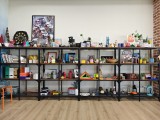

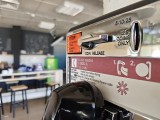
Daylight samples, main camera (1x), Vivid (default)
As with most recent vivos, there are two more processing modes other than the default Vivid one. The Textured look makes slanted edges and detail in general appear a bit more jagged still, and exposures get a little bit moodier. The Zeiss Natural mode, on the other hand, lowers contrast and tones down saturation.
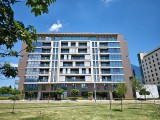



Daylight samples, main camera (1x), Textured
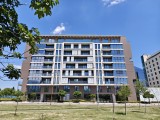



Daylight samples, main camera (1x), Zeiss Natural
You can also check out a few photos of our resident people shots model, in both Photo mode and Portrait mode. We're not entirely sure what's happening with the T-shirt in that second photo from Photo mode, but other than that, things are looking pretty good.




Daylight samples, main camera (1x), Photo mode




Daylight samples, main camera (1x), Portrait mode, 24mm
The full-res 50MP samples from the X Fold3 Pro look a little brighter, and have a bit more blown out highlights. We wouldn't say there's a detail advantage in those.




Daylight samples, main camera (1x), 50MP
We've typically gotten impressive results from vivos at 2x on models without 2x cameras, but the X Fold3 Pro's samples are just okay.







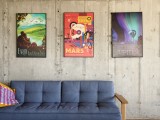
Daylight samples, main camera (2x)
Similarly, the 2x shots of people aren't quite praise-worthy, but will do the job. The intermediate 35mm magnification in Portrait mode actually offers the best balance between image quality and perspective.




Daylight samples, main camera (2x), Photo mode




Daylight samples, main camera (2x), Portrait mode, 50mm




Daylight samples, main camera (2x), Portrait mode, 35mm
3x telephoto camera
The 3x telephoto camera takes wonderful photos. They're noise-free and packed with detail that is also drawn organically. Dynamic range is excellent and colors are great too. The camera excels at close-ups, too. Top stuff all around.








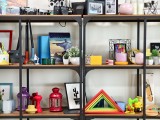





Daylight samples, telephoto camera (3x)
The telephoto is also an excellent choice for shots of people, even without resorting to Portrait mode. That said, if you want some extra background blur or one of the Zeiss simulations, the Portrait mode with its two magnifications will serve you well.




Daylight samples, telephoto camera (3x), Photo mode




Daylight samples, telephoto camera (3x), Portrait mode, 85mm




Daylight samples, telephoto camera (3x), Portrait mode, 100mm
The full-res mode on the telephoto has somewhat of hazy look, but does have potential as a stepping stone if you want to do your own processing.




Daylight samples, telephoto camera (3x), 64MP
The 10x zoom level isn't strictly as high-quality as the 3x one, naturally, with detail being softer and more processed looking. Still, it's perfectly fine for quick snaps of distant subjects to send in the group chat.




Daylight samples, telephoto camera (10x)
Ultrawide camera
The ultrawide is also a competent performer. It's not the most ultra of ultrawides, but it does still offer extra coverage or exaggerated perspectives of close ups - the autofocus makes the latter possible, and you don't get that on the Galaxy Z Fold6.
Its colors are typically accurate and well matched to the main camera's (the Vespa is a bit off, but it's not the easiest to get right anyway). Dynamic range is great too.






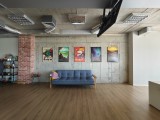

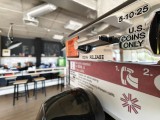

Daylight samples, ultrawide camera (0.6x)
The full-res mode produces upscaled versions of the 12.5MP shots and we don't see much use in it.




Daylight samples, ultrawide camera (0.6x), 50MP
Selfies
As with all foldables, there are many ways to capture selfies on the X Fold3 Pro. The cover and the internal camera take essentially the same shots, only the process of capturing selfies with a tablet is less elegant.




Selfie samples, internal camera
Naturally, the rear camera will get you nicer results, with livelier colors, wider dynamic range and some nice separation from the background thanks to its inherently shallower depth of field.

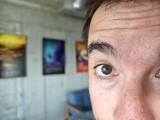


Selfie samples, rear camera, 1x
The ultrawide will allow you to capture more of your surroundings, or do odd angles and closeups thanks to its autofocus capability.




Selfie samples, rear camera, 1x
Low-light photo quality
Once darkness sets in, the X Fold3 Pro produces essentially the same photos in full Auto as it would in the dedicated Night mode, as most recent high-end vivos we've encountered. You get a subtle notification of its Night mode processing in Photo mode with a crescent icon in the viewfinder corner - neither the icon gets in the way, nor the processing.
Main camera
The main camera's low-light photos have very likable tonal properties - dynamic range is extra wide, with well-contained highlights plus shadow brightening that's among the more aggressive out there, and if you like actually seeing stuff in your low-light photos, you'll love the X Fold3 Pro's results. Colors are nicely vibrant too.
Detail is very good, though not quite as crisp as it is during the day, perhaps as a direct result of the low-light processing.











Low-light samples, main camera (1x)
At 2x, the photos can be described as decent to okay, depending on how much light there is. Darker scenes have notably softer detail and an upscaled quality, while better-lit facades are about as detailed at night as they are during the day.








Low-light samples, main camera (2x)
3x Telephoto camera
The telephoto revels in the night - it's probably better than the main camera. The one half-issue is with some types of lighting that can turn overly orange, but other than that, there's little to complain about. Detail is great both far and near; dynamic range is excellent.











Low-light samples, telephoto camera (3x)
At the 10x zoom level, things do get water-color-y in darker scenes. Then again, lighter settings like the one in the fourth sample, can look quite alright.




Low-light samples, telephoto camera (10x)
Ultrawide camera
The ultrawide's low-light photos aren't as exciting, but they're anything but a disappointment either. We're getting well-exposed shots with wide dynamic range and very good development at either end of the histogram. Colors are also looking nice. It's just that detail is a little sketchy, that's all.








Low-light samples, ultrawide camera (0.6x)
Video recording
The vivo X Fold3 Pro can record video up to 4K60 with its three rear cameras, and 8K30 is also available on the main one. There's also a Pro video mode with extra frame rates - 24fps, 25fps and 50fps are also available in 4K (but no 4K120), as well as 24fps and 25fps in 8K.
The default codec is h.264 but you can switch to h.265. There is 'regular' video stabilization available in all resolutions and frame rate combos. It can't be disabled - even though the viewfinder shows a crossed-out icon for stabilization in its default state. That's because the toggle actually controls the 'Ultra stabilization' which offers added stability but limits your resolution to 1080p (still, at either 30fps of 60fps).
You can check out the playlist below, which includes multiple video samples.
The X Fold3 Pro's videos are alright, but not particularly impressive. The main camera's 4K30 is on the soft side, and the telephoto doesn't look too sharp either, though at least the ultrawide is pretty good in its own context. 4K60 is consistently softer than the 30fps on all three. Colors are good in all cases, so at least there's that. Oddly enough, dynamic range looks wider at 60fps, at least to our eyes.
On a positive note, stabilization is excellent. Walking shake is ironed out really well and doesn't cause focus hunting. Pans are smooth too, with particularly nice transitions at both ends. Pointing the phone in one direction also results in steady footage.
In low light, the results are adequate, though they're again somewhat softer than we'd expect. Contrast is relatively low on all cameras and there's a mild desaturation at play.
Reader comments
- Anonymous
- 22 Jan 2025
- 3xC
Dear, please help if you did find any solution for the Teams issue I am facing the same once I press the icon the app launches then immediately crashes
- Milan987
- 13 Sep 2024
- 8qm
You are probably wrong. I am 75 years old. a pensioner from Slovakia and I change mobile phones every 2 years. Cloning works so no problem with replacement. And the VIVO X FOLD3 PRO is excellent
- Mansoor ali
- 08 Sep 2024
- KIw
Wow ots amazing its affordable and very brilliant



